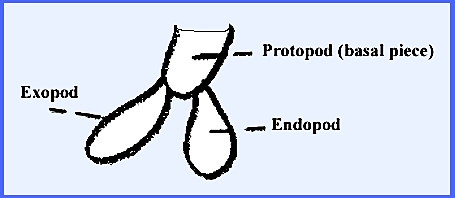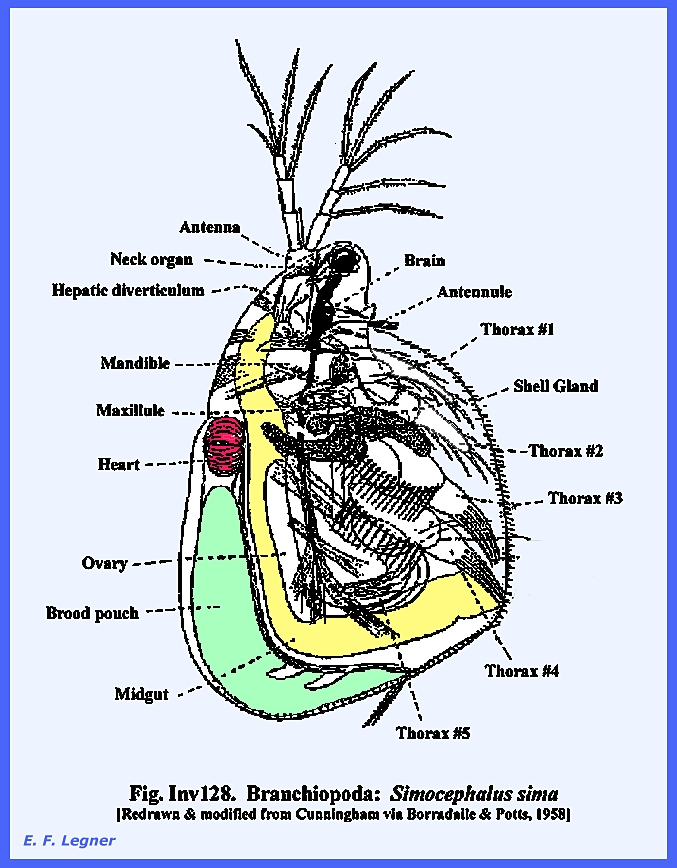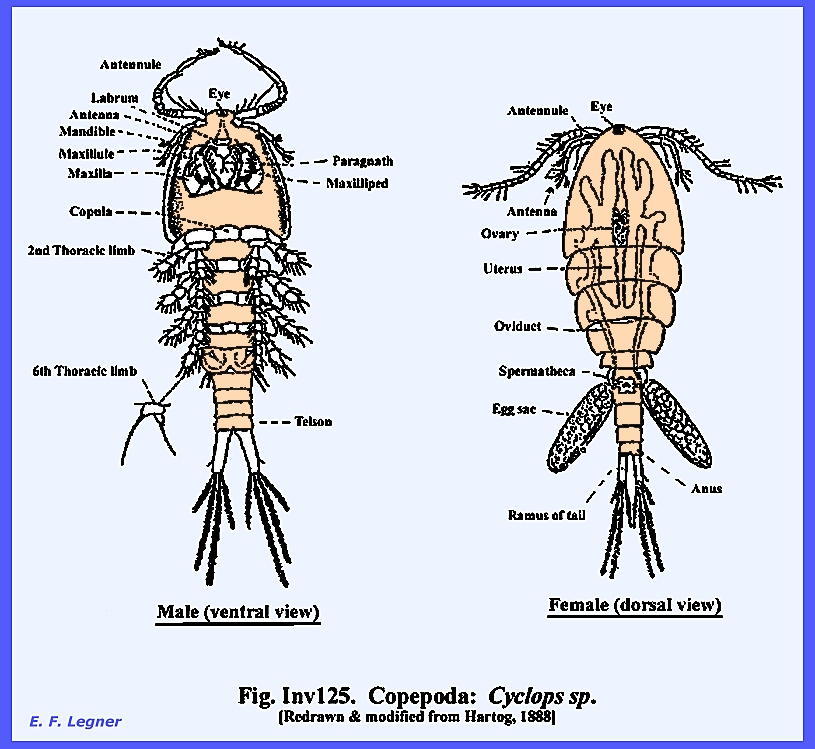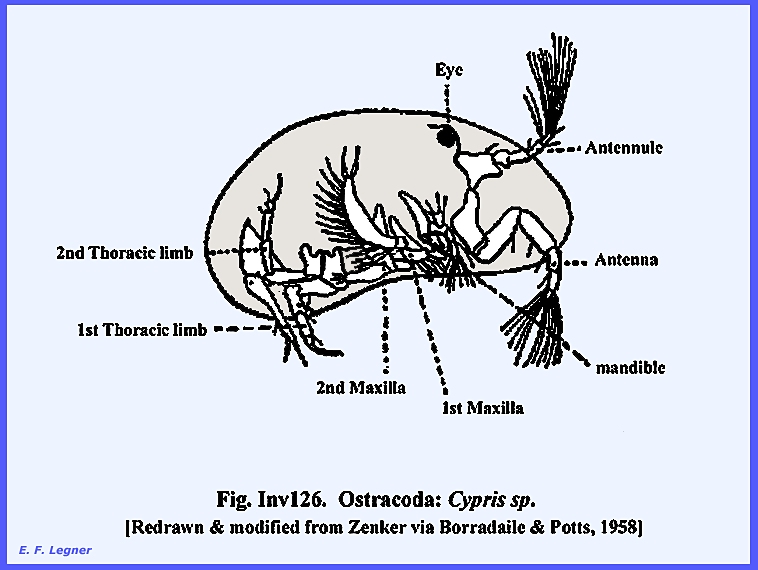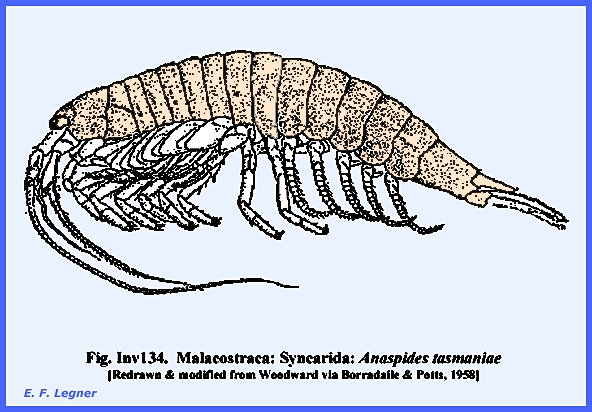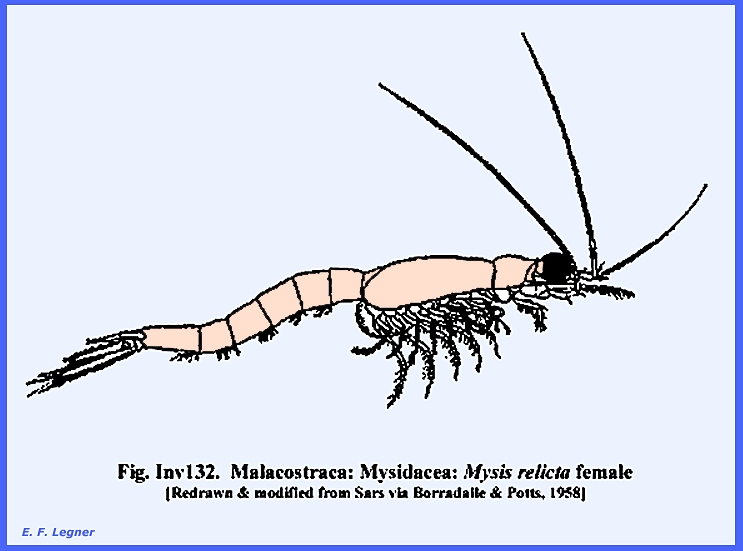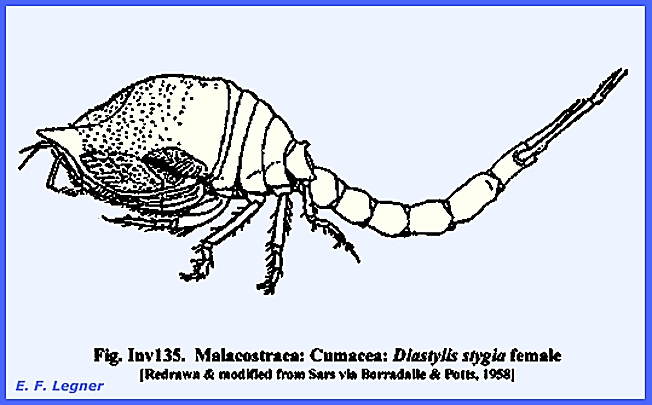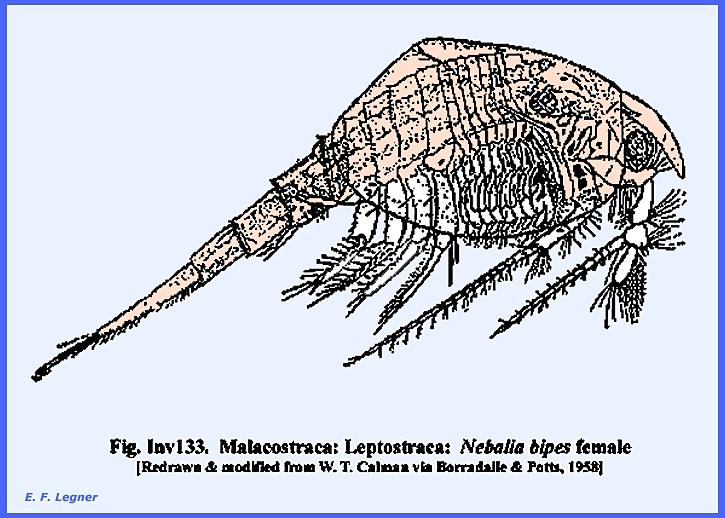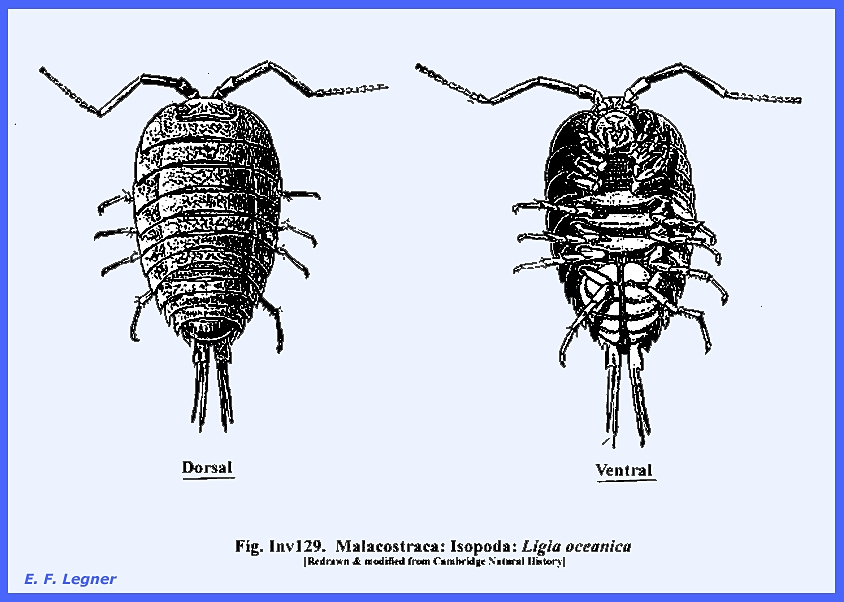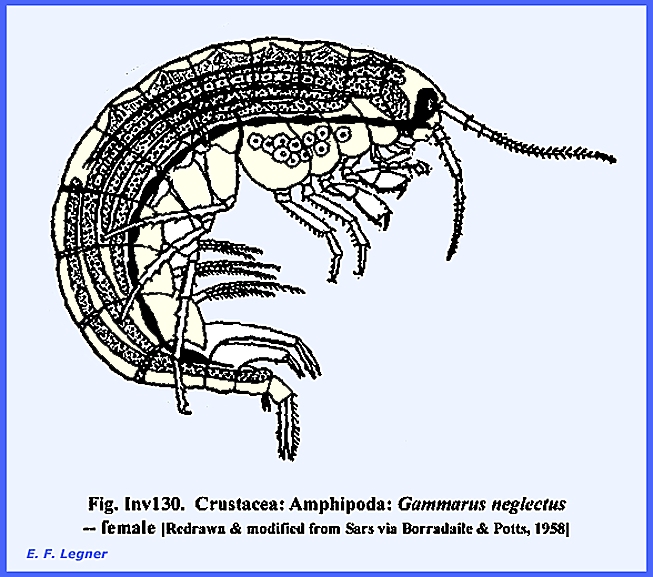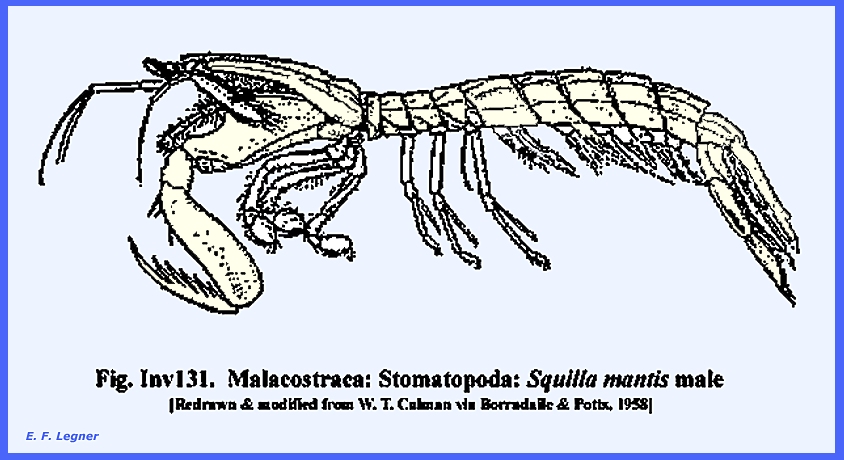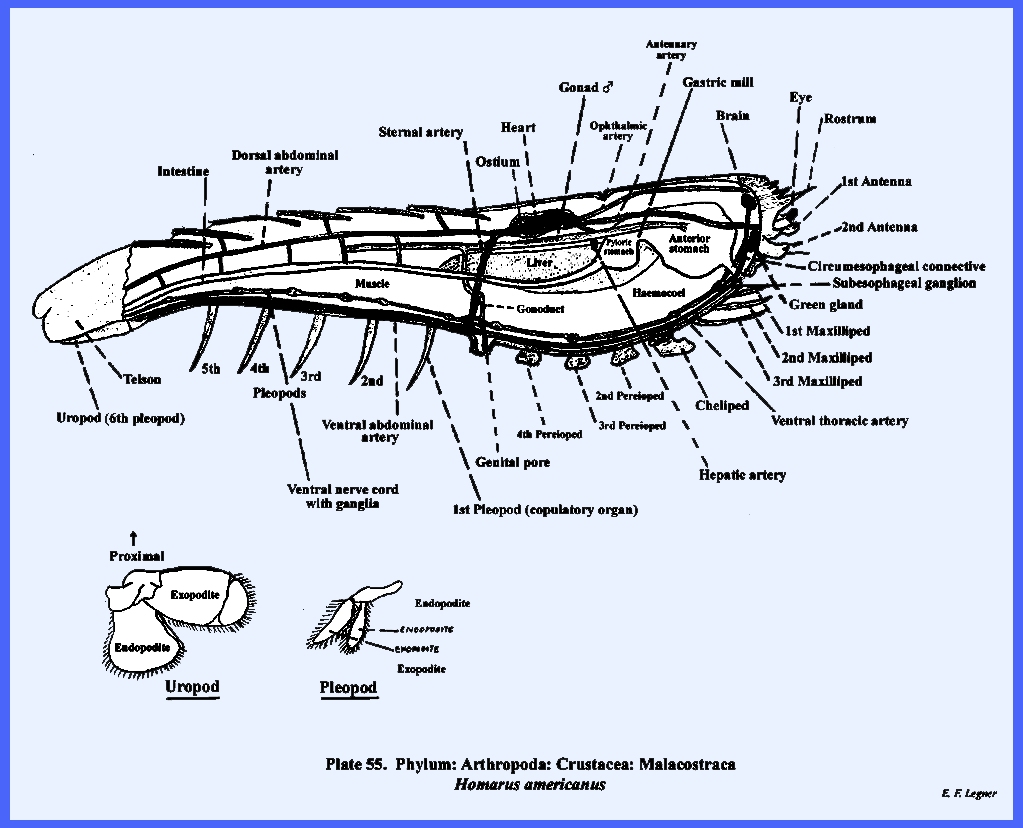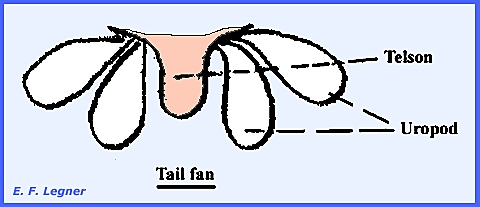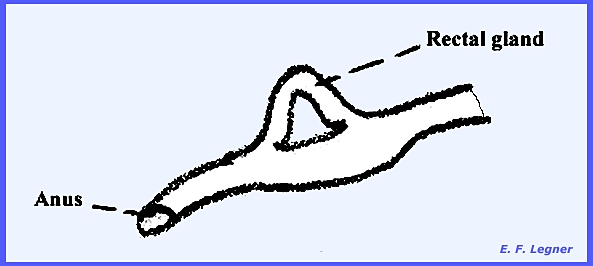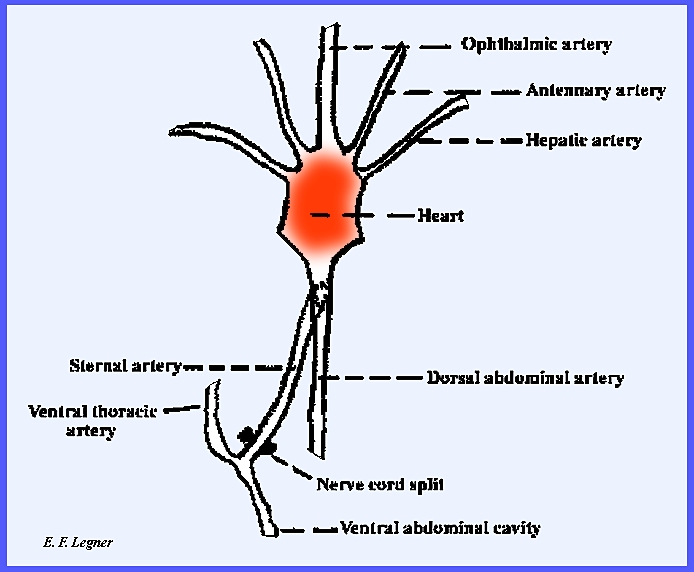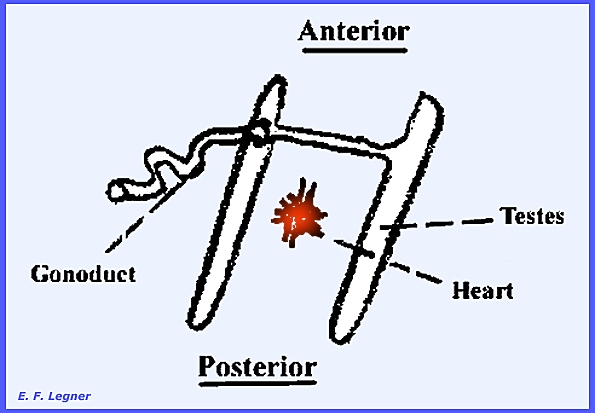File:
<crustacea.htm> <Index to Invertebrates> <Bibliography> <Glossary> Site Description <Navigate to Home>
|
Invertebrate
Zoology Kingdom: Animalia, Phylum: Arthropoda, Subphylum: Crustacea (Contact)
CLICK on underlined file names and included
illustrations to enlarge: The Subphylum: Crustacea
is a group of mostly aquatic, and marine, animals. Some terrestrial forms are restricted to damp sites. They may be identified by having the
following characteristics: Head
Appendages. -- Two pairs of
antennae located on the 1st and 2nd segments. One pair of mandibles used
for crushing. Two pair of jaw-like
structures called maxillae
on the 1st and 2nd
segments. Origin
of Appendages. --The origin of
appendages is from primitively biramous structures: protopod, exppod and endopod. Cephalothorax.
-- The head and thorax are fused in many cases to produce the cephalothorax. Carapace.
--This structure covers the head and one or more thoracic segments. It is variable in size and attached only
to the head and some thoracic segments.
It is frequently very conspicuous. Excretory
System. -- One pair of
nephridia are involved in excretion.
They occur either at the base of the second maxilla or at the base of
the second antenna. They are often
called "green glands." Circulation.
-- The heart and some vessels may occur in the haemocoel to circulate the
blood. Blood is colorless and may
contain haemocyanin or haemoglobin.
The blood also is able to carry much oxygen in contrast to the
terrestrial arthropods where blood carries very little oxygen. Larval
Stage. --A Nauplius larva
is present. Respiration.
-- This usually involves gills. ------------------------------------ The Class: Branchiopoda,
whose name means "gill-feet" includes
primarily freshwater species. Some
are able to swim by using their antennae.
They are fee living with compound eyes and usually a carapace. The mandibular palp is rarely present. They show both primitive and specialized
characters. See Inv128
for example. The Order Phyllopoda
includes the fairy
shrimp, tadpole
shrimp
and brine
shrimp. These are primarily
small (5 cm.) freshwater species with gills on their legs. They differ from other crustaceans by the absence
of the 2nd maxilla. Some species
display up to three reproductive strategies:
bisexual, parthenogenesis and hermaphroditic. The elongated tails structures are
frequently as long as the remaining body. The Order Cladocera
includes Daphnia species. They are free-swimming crustaceans that
tend to swim with their dorsal side up.
They have a two-valve carapace that covers most of the body save for
the appendages. In some members the
carapace covers only the brood pouch.
The head is generally separated from the body by a deep
indentation. It projects forward as a
beak or rostrum. On the front of the
head there is a single compound eye, which is derived from two fused
eyes. Most species also have a simple
naupiliar eye. ------------------------------------ Please see
following plate for Example Structures of the Branchiopoda: Plate 49 = Phylum: Arthropoda: Crustacea:
Branchiopoda, Copepoda & Ostracoda ------------------------------------ The Class Remipedia include a group of blind crustaceans that occur in coastal
aquifers containing saline groundwater, with members found in almost every
ocean basin. The first described remipede was the fossil Tesnusocaris
goldichi (Lower Pennsylvanian), but, since 1979, at least seventeen
living species have been identified with global distribution throughout the
Neotropics. Their
size is variable from 10–40 millimetres long and include a head and an
elongated trunk of up to forty-two similar body segments. Swimming appendages are lateral on each
segment, and theyswim on their backs. They are slow-moving. They have fangs
connected to secretory glands; it is still unknown whether these glands
secrete digestive juices or poisonous venom, or whether remipedes feed
primarily on detritus or on living organisms. They have a primitive body plan
for crustaceans, and have been regarded as an ancestral crustacean group.
However, least one species, Godzilliognomus frondosus, has a highly
organised and well-differentiated brain, with a large olfactory area that is
a common feature for species that live in dark environments. The size and
complexity of the brain suggests that Remipedia might be the sister taxon to
Malacostraca, regarded as the most advanced of the crustaceans ------------------------------------ Class: Cephalocarida – horseshoe
shrimp are small, 2-4 mm. crustaceans that have an elongated body and a large
head, the posterior edge of which covers the 1st thoracic segment. Eyes are absent and the 2nd pair of
antennae is located posterior to the mouth, which is unique for the
Crustacea. The mouth is behind the
upper lip and mandibles occur on either side. The 1st pair of maxillae is very small and the 2nd pair has the
same makeup as the following thoracic legs.
A large basal area has outgrowths on the inner side that are used for
locomotion. A forked inner branch and
two outer lobes, or pseudoepipod and exopod, are present. Maxillae are unspecialized. There are 10 thoracic segments and the
abdomen bears a telson but no other appendages. ------------------------------------ Class: Maxillopoda –
barnacles, fish lice, etc. Subclass: Cirripedia are the
barnacles. They are the only
Crustacea, which are frequently sessile.
They are typically hermaphroditic.
A carapace encloses the entire body and is very heavy by being
impregnated with calcium salts. All
species are found in the marine environment, and some are parasitic. See Inv127 for examples Subclass: Copepoda includes the genus Cyclops. They are primarily marine organisms bud some species also occur
in freshwater. They have a single
median eye and swim by means of their antennae. Parasitic forms are common. See Inv125 for example. ------------------------------------ Please see
following plate for Example Structures of the Copepoda: Plate 49 = Phylum: Arthropoda: Crustacea: Branchiopoda,
Copepoda & Ostracoda ------------------------------------ Class: Ostracoda –
seed shrimp. They have the appearance
of clams because their carapace is bivalved.
They are very tine and live in marine and freshwater environments. In
northeastern North America they are some of the first animals to appear in
ponds in springtime. They differ little in form of the body but have a great
variety of appendages. Their cephalic
limbs are well developed and complex.
There is frequently a gastric mill and usually a pair of hepatic
caeca. Antennal and maxillary glands
are present. Parthenogenesis is
common in some species males are unknown.
See Inv126
for example ------------------------------------ Please see
following plate for Example Structures of the Ostracoda: Plate 49 = Phylum: Arthropoda: Crustacea: Branchiopoda, Copepoda &
Ostracoda ------------------------------------ The Class: Malacostraca –
have abdominal appendages and a definite number of segments: Head = 6, Thorax = 8 and Abdomen = 6. The eggs hatch into more advanced larvae
(e.g., Mysis larvae) Eight principal groups are shown
as follows: Syncarida A superorder of Melacostraca called "mountain
shrimps." They lack a carapace
and oostegites but have exopodites on all thoracic limbs. Eyes are sessile or stalked or completely
absent. The exopod is in the shape of
a whip.. They live in freshwater
lakes and streams. They appear to be
confined to the Southern Hemisphere. See Inv134 for example. Order: Mysidacea.
-- Primarily marine animals. They
have a carapace, which covers most of the thoracic somites. They have stalked eyes. These are small normally pelagic
animals. See Inv132 for example. Order: Cumacea is
a small group of marine or brackish water organisms often called "hooded
shrimps." They have a uniform body plan that
distinguishes them from other Crustacea.
There is an enlarged carapace, a slender abdomen and forked tail. They are small ranging up to 10 mm
long. They have two eyes that are
often fused in some species. They
have a short life span living in benthic mud and debris. They are frequently observed swarming at
the water surface. See
Inv135 for
example. Order: Leptostraca are
marine organisms that are principally filter feeders. Some authorities consider them to be the
most primitive members of the Malacostraca.
They are small, ranging to about 16 mm long. They have eight abdominal segments instead of the usual
six. Their compound eyes are
stalked. The carapace is very large
and covers the head and thorax. Eggs
hatch to produce a Manca
stage
immature
individual. See Inv133 for
example. Order: Isopoda.
-- The pill bugs or sow bugs are flattened dorso-ventrallay. Abdominal appendages are modified into
gills. Both terrestrial and marine
species occur. Terrestrial species
are widespread and found under rocks and garden wastes where they often
abound. See Inv129
for example. Order: Amphipoda.
-- Primarily marine. They do not have
a carapace. The eyes are sessile and
the body is usually depressed. There
is much variety exhibited in the group.
See Inv130
for example. Order: Stomatopoda.
-- Includes the mantis shrimp,
a burrowing form. They have a shallow
carapace that is fused with three thoracic somites. The 2nd thoracic limb has a large, raptorial
subchela. They are all marine and live primarily in
burrows. See Inv131 for example. Order: Decapoda.
-- The order is divided into three suborders which are (1) Macrura =
"Big Tail" includes lobsters and crayfish, (2) Anomura
= Peculiar tail" includes the hermit
crab, and (3) Brachyura
= "Short
Tail" includes the crabs. The lobster, Homarus americanus,
is an example animal for the Malacostraca: Decapoda: Macrura. It is a marine animal that burrows along
rocky ocean shores (See Plate
55) Body Plan.
-- The cephalothorax is covered by one carapace. The anterior tip bears the rostrum,
which protects the eyes and other sense organs in the region. Abdominal segmentation is very
conspicuous. Body
Wall. -- The exoskeleton is chitinous and covers
the entire body. It also has high
protein content and the calcium salts that impregnate it give it hardness. The epidermis is derived from the
hypodermis. Connective tissue does
not form a thick layer. Muscles are
not in a continuous tube or sheath, but are broken up into a particular
segmental pattern. The haemocoel serves for
circulation of the blood, and functions by a sloshing about of the blood. Head
Appendages. -- There are six
segments in the head, the most anterior of which does not bear appendages. The 1st antennae are small, not
biramous, and sensory to tactile and chemical stimuli. Statocysts in
the base contain grains of sand. The 2nd antennae are large and
biramous. The exopod is scale-like
while the endopod is a long major branch.
It is tactile and chemical sensory.
The excretory pore, or green gland, lies at the base. The mandibles function as crushing
structures. The maxillae are
accessory mouthparts that function in the manipulation of food. They are sensory also. The 2nd maxilla bears a gill
bailer, which bails water out
of the front end of the gill chamber. Thorax
Appendages. -- There are eight
segments in the thorax. The 1st, 2nd
and 3rd are maxillipeds. These are leg-like appendages that are
modified into extra mouthparts. They
function to manipulate the food and are partially sensory. Five pairs of pareiopods are
the "walking legs." The first pair is large pincers called chelipeds;
the second and third pair is small chelate pincers, and the fourth and fifth
pair is nonchelate pincers. The legs are modified into
structures for defense and offense.
They are pincer-like at the end (= chelate). The third and fifth pair is referred to as the coxopodite, the
3rd pair being the female genital pore and the 5th pair the male genital
pore. The exopods are lost during
development. Gills are borne on the bases of
the thoracic appendages. Abdomen
Appendages. -- The first pair is
modified into a copulatory organ in the male, while in the female these are
reduced to a vestige. [Note: in the crayfish these are the first two
pairs] The second through fifth pair of
abdominal appendages are pleopods or
gills that create water current. The sixth pair are uropods, which
form the tail fan. Food
& Digestion. -- Fish and some
clams and snails constitute the food.
These are captured by chelipeds and food is passed on to the
mouthparts and to the mouth. The
mouth is ventrally located near the mandibles. The esophagus opens into the cardiac
stomach. This is a gastric mill with
three teeth that is modified to chew food.
The teeth are shed at molting. The midgut is a tube that contains
digestive glands or a liver. The intestine ends in the rectum
with a rectal gland and anus. Digestion is intracellular and
extracellular, with a major portion occurring in the digestive gland or
liver. Circulation.
-- The heart, located dorsally, has three pair of ostia,
which admit the blood. Seven arteries
lead out away from the heart. They are (1) ophthalmic
artery
to the head, (2) antennary
artery to the base of
antennae, (3) hepatic artery to
the digestive gland, (4) sternal artery to
ventral parts of the animal, which passes between a split in the ventral
nerve cord and then divides into two branches, (5) dorsal
abdominal artery, (6)
ventral thoracic artery, and (7) ventral
abdominal artery. The arteries simply open out into the spaces of the
haemocoel. Blood runs from the haemocoel to
the gills and back to the haemocoel again via ostia of the heart. The blood contains haemocyanin and has
colorless corpuscles that are believed to function in coagulation. Respiration.
-- The gills are outgrowths of the body wall and covered by a lateral flap of
the carapace. The early recognition
that gills are part of the exoskeleton provided evidence for their being
molted. It was much later also
recognized that the counterparts of gills, the tracheoles of insects, were
similarly involved in the molt. The swimmerets circulate water around the gills, and the gill
bailer pulls water out the front end through the 2nd maxilla. Excretion.
-- The green glands located at the base of the 2nd antennae are involved in
the excretion process. These glands
are similar to nephridia but they are bathed in a haemocoel and not a coelom
as is true of nephridia. Support
& Protection. -- The exoskeleton is
very hard and rigid, while the pincers are formidable defense weapons. Locomotion.
-- Homarus can only walk; there is
no swimming of adults as the body is too heavy. The abdomen pushes the animal along backwards. Sense
Organs. -- There are sense
organs located on the 1st and 2nd antennae, as well as on the
mouthparts. The compound
eyes
are well developed and
consist of a large number of ommatidia with
square ends. Each ommatidium consists
of a cornea, pigmented cells, a lens and a nerve element. Statocysts are hollow cavities
with sensory cells at the base of the 1st antennae. They are an inpocketing from the surface (ectoderm and cuticle
on the inside). Molting results in a
loss of statoliths (sand grains), which must be
reacquired after each molt. Nervous
System. -- The system is very
similar to that of the Annelida.
There is a dorsal brain, circumesophageal connectives, and a double,
solid, ganglionated ventral nerve cord. The brain is larger and more
subdivided, however. Fusion of
ganglia is in the anterior part of the body. Reproduction.
-- The sexes are separate in Crustacea.
Genital openings are located on the 3rd peripod in the female and the
5th peripod in the male. The annulus
ventralis
is the seminal
receptacle of the female located on the posterior part of the 5th periopod,
and is not connected with the genital tract. In the male a sperm
guide is located
on the first pair of pleopods, which have become modified. Fig. Inv123 shows the relative positions of the
heart, testes and gonoduct. Sperm is stored in the seminal
receptacle of the female, and they are liberated at egg laying time. Eggs are attached by a sticky secretion to
the swimmerets of the female and undergo most of their development
there. Most larval stages are in the
egg. Mysis
larvae occur
that swim until after the third molt. ------------------------------------ Please see
following plates for more Example Structures of the Malacostraca: Plate 55 = Phylum: Arthropoda: Crustacea: Malacostraca: Homarus americanus -- General Morphology Plate 56 = Phylum: Arthropoda: Crustacea: Malacostraca: Homarus americanus -- Limb Structure Plate 57 = Phylum: Arthropoda: Crustacea: Malacostraca: Homarus americanus -- Mouthparts Plate 58 = Phylum: Arthropoda: Crustacea: Malacostraca; Orders: Isopoda,
Amphipoda, Stomatopoda --Ligia oceanica, Gammarus neglectus,
Squilla sp. Plate 59 = Phylum: Arthropoda: Crustacea: Maxillipoda & Malacostraca -- Lepas anatifera, Mysis relicta ============== |
